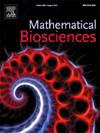Role of non-exponential reversal times in aggregation models of bacterial populations
IF 1.8
4区 数学
Q2 BIOLOGY
引用次数: 0
Abstract
Individual bacteria typically follow somewhat simple rules of motion, but collective behavior can exhibit complex behavioral patterns. For instance, the formation and dispersal of aggregates of reversing bacteria in biofilms are primarily driven by coordinated motion among cells. Many mathematical models of aggregation assume that cells have no memory, e.g., the time between their behavior changes, such as direction reversals, is exponentially distributed. However, in practice, the distribution is quite distinct from exponential. Therefore, in this paper, we analyze numerically the importance of non-exponential reversal times in 1D agent-based and kinetic models of aggregation. In particular, we consider these models in a practical parameter regime by fitting a Gamma distribution to represent the run times of myxobacteria and study their collective behavior with exponential and non-exponential reversal times. We demonstrate that non-exponential reversal times aid aggregation and result in tighter aggregates. We compare and contrast the behavior of agent-based and kinetic models that consider aggregation driven by chemotaxis. Thus, incorporating non-exponential reversal times into models of aggregation can be particularly important for reproducing experimental data, such as aggregate persistence and dispersal. These results provide a simple example of how the existence of memory helps bacteria coordinate their behaviors.
非指数反转时间在细菌群体聚集模型中的作用。
单个细菌通常遵循一些简单的运动规则,但集体行为可以表现出复杂的行为模式。例如,在生物膜中,逆转细菌聚集物的形成和扩散主要是由细胞间的协调运动驱动的。许多聚集的数学模型假设细胞没有记忆,例如,它们的行为改变(如方向逆转)之间的时间是指数分布的。然而,在实践中,这种分布与指数分布是完全不同的。因此,本文从数值上分析了非指数反转时间在一维智能体聚合模型和动力学模型中的重要性。特别是,我们通过拟合Gamma分布来表示黏菌的运行时间,并研究它们在指数和非指数逆转时间下的集体行为,从而在实际参数范围内考虑这些模型。我们证明了非指数反转时间有助于聚合并导致更紧密的聚合。我们比较和对比基于代理和动力学模型的行为,考虑由趋化性驱动的聚集。因此,将非指数逆转时间纳入聚集模型对于再现实验数据(如聚集持久性和分散)尤为重要。这些结果为记忆的存在如何帮助细菌协调它们的行为提供了一个简单的例子。
本文章由计算机程序翻译,如有差异,请以英文原文为准。
求助全文
约1分钟内获得全文
求助全文
来源期刊

Mathematical Biosciences
生物-生物学
CiteScore
7.50
自引率
2.30%
发文量
67
审稿时长
18 days
期刊介绍:
Mathematical Biosciences publishes work providing new concepts or new understanding of biological systems using mathematical models, or methodological articles likely to find application to multiple biological systems. Papers are expected to present a major research finding of broad significance for the biological sciences, or mathematical biology. Mathematical Biosciences welcomes original research articles, letters, reviews and perspectives.
 求助内容:
求助内容: 应助结果提醒方式:
应助结果提醒方式:


